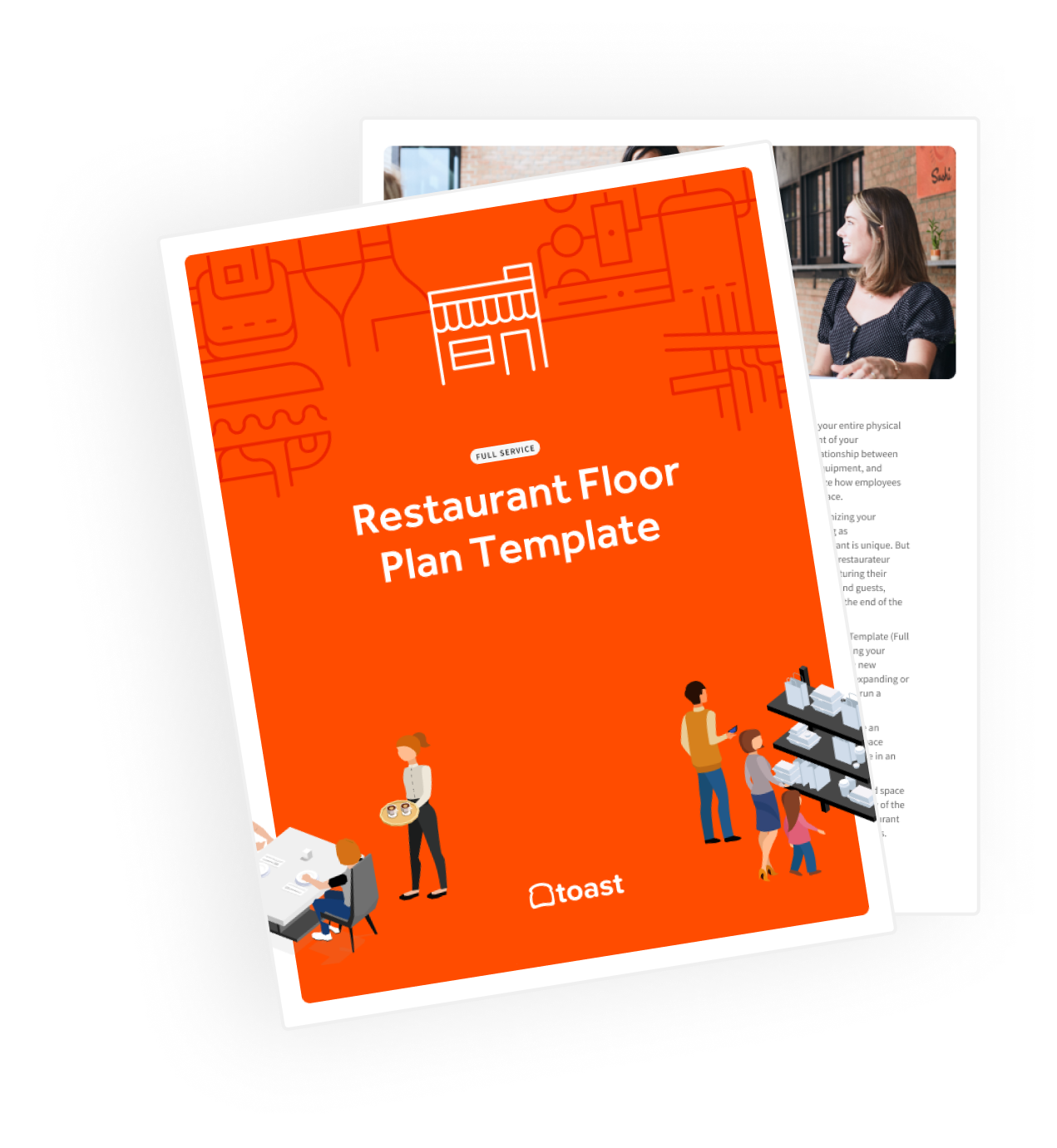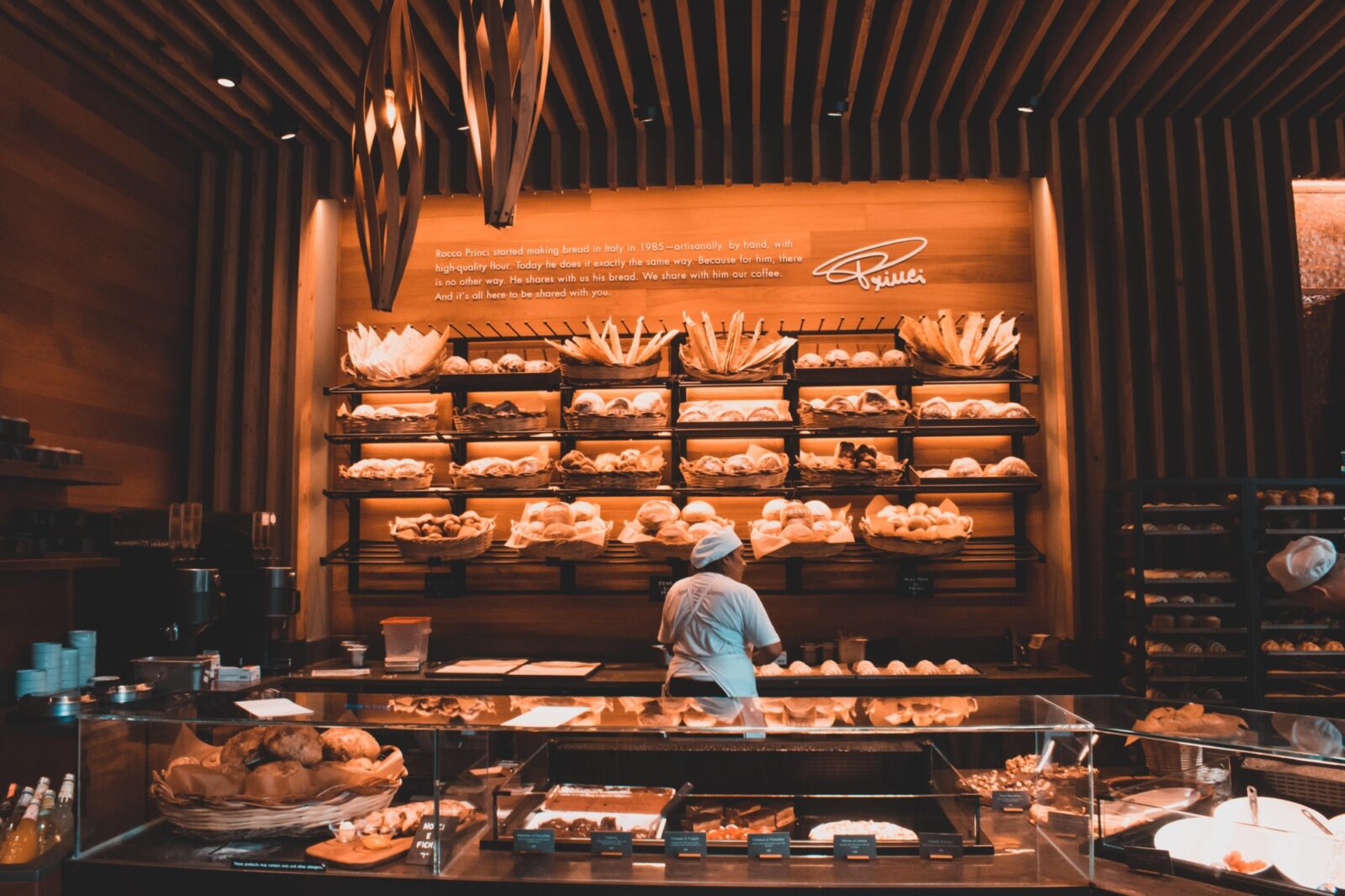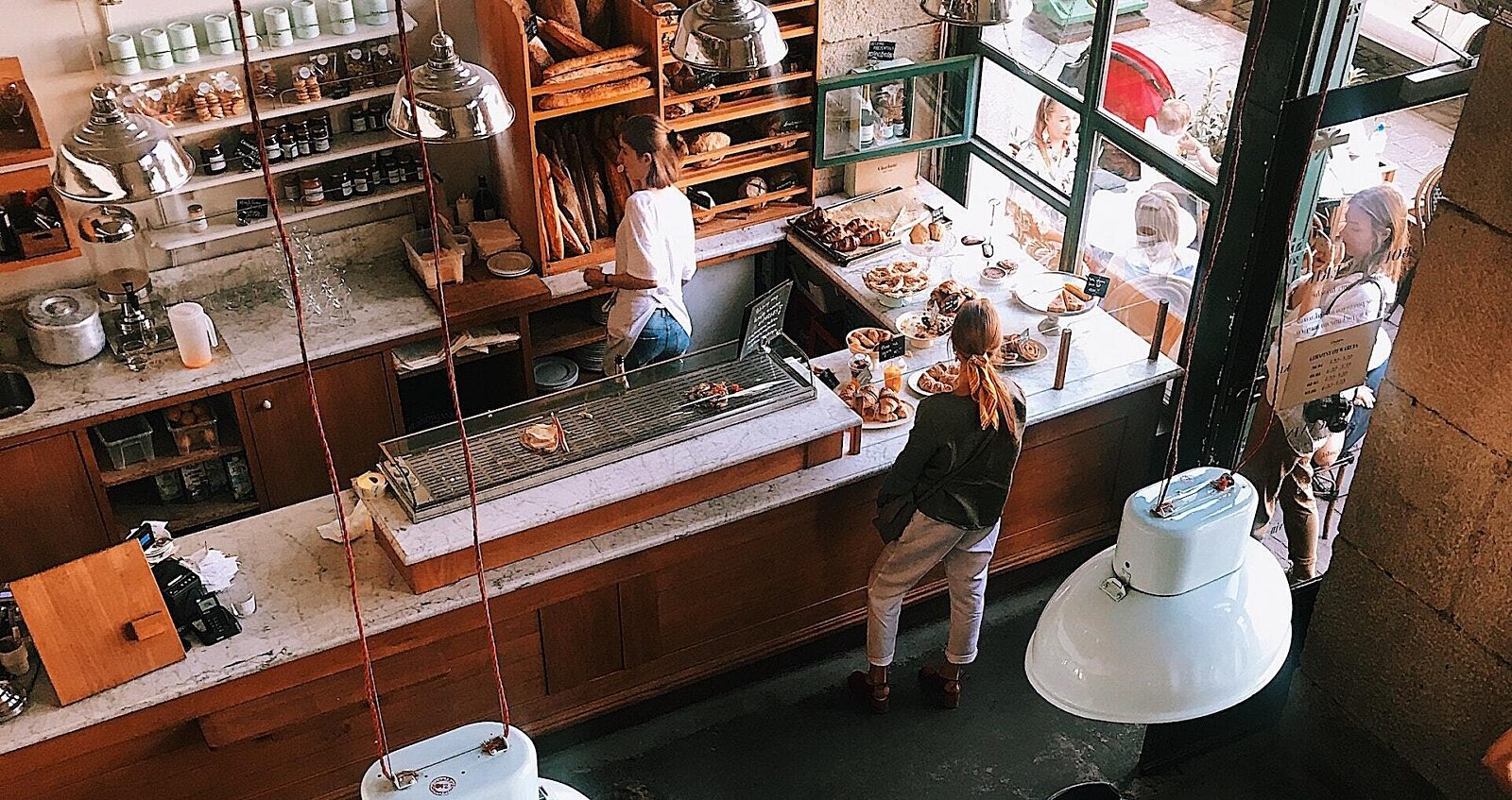
How to Design a Bakery Floor Plan, Layout and Blueprint
Build a bakery that’s a treat from top to bottom with thoughtful blueprints and floor plans.
Tyler MartinezAuthor


Restaurant Floor Plan Templates
Use these restaurant floor plan templates to get inspired as you map, or reimagine, the layout and space setup for your restaurant.
Get free downloadBakeries are warm and comforting, and as the owner, you have a responsibility to ensure that the space is accessible to all guests. Many states require businesses to submit blueprints for building permits before they can open.
To create a memorable experience for your guests and a comfortable space for your employees, and meet all the legal requirements for your bakery, you’ll need to design an intuitive restaurant floor plan. This guide will help you do just that, to set your bakery up for long-term success.
Restaurant Floor Plan Templates
Use these restaurant floor plan templates to get inspired as you map, or reimagine, the layout and space setup for your restaurant.

What is a Bakery Floor Plan?
A bakery floor plan is a map of the physical space of the entire restaurant. Every inch of space needs to be accounted for, indoors and outdoors. Ultimately, the floor plan lets you visualize how all the spaces of your bakery fit together.
Floor plans require a little research and creativity – the floor plan must balance your vision for the bakery while being accessible for everyone. How your guests and employees navigate your bakery is just as important as the ambiance and experience.
A bakery floor plan should include:
- Prep areas
- The kitchen
- Entrance areas
- Waiting areas
- Dining and seating areas
- Staff areas, offices, and break rooms
- Your bakery’s POS system and cashier stations
- Restrooms
- Dish area(s)
- Doors
- Windows
- Emergency Exits
- Accurate measurements of the space
Options for Creating a Bakery Floor Plan
There are two options when it comes to starting the design process for your bakery – do it yourself or hire a designer.
You can design your bakery’s floor plans without becoming an architect, artist, or designer. Software can help make designing your bakery’s floor plans and blueprints simple. SmartDraw, ConceptDraw, or CadPro are all reliable software programs that can create a custom blueprint for your bakery.
You can also hire designers to create your floor plans. An interior design studio can help bring your vision to life in full color. The right designer will work with you to hone a focused aesthetic for the bakery.
No matter which option you choose, make sure you start with an idea of how you want the bakery to function and flow. Where will the kitchen be? The dining areas? Where will guests enter and place orders? Double-check that your layouts are accessible to all kinds of guests.
Bakery Business Plan Template
Use this free bakery business plan template to easily create a great business plan that organizes your vision and helps you start, grow, or raise funding for your bakery.

Accessibility Requirements for Bakery Floor Plans
States and municipalities have building codes that public buildings must adhere to. Complying with building codes guarantees that your bakery is accessible to all guests. But, as architect Justin Alpert says, adhering to building codes is the bare minimum – think about how you might design a space that works for everyone, not just “the average customer.”
When designing your floor plan, take inspiration from the humans that will use the space. Employing the principles of human-centered design not only results in beautiful, usable bakery spaces but can also lead to more customer engagement. As you start designing, answer this question – how can you engage all of your community with the design of your bakery?
The answer will all depend on you, your community, and your vision for your dream bakery!
How to Create a Bakery Blueprint and Floor Plan
It’s important to learn about creating a blueprint and floor plan for your bakery, whether you’re working with a designer or doing it yourself. This guide will help you get an idea of how to start the design process, which all begins with using floor plan design software to create a map of each of the spaces in your bakery using the best practices.
Floor Plan Design Best Practices:
- Design accessible spaces with your customers in mind. Consider both your guests’ and employees' needs as well as local building codes when designing.
- Include ample space for your guests while they wait in line to order or, if your bakery has table service, while they wait for a table.
- Create an intuitive flow of service so that customers are not confused by how your bakery functions.
- Factor in where your employees will be working. This includes identifying where POS systems will exist to efficiently conduct transactions and communicate with the kitchen.
- Consider how the floor plan works for the theme and ambiance of your bakery.
Here’s an example of a bakery floor plan from ConceptDraw:
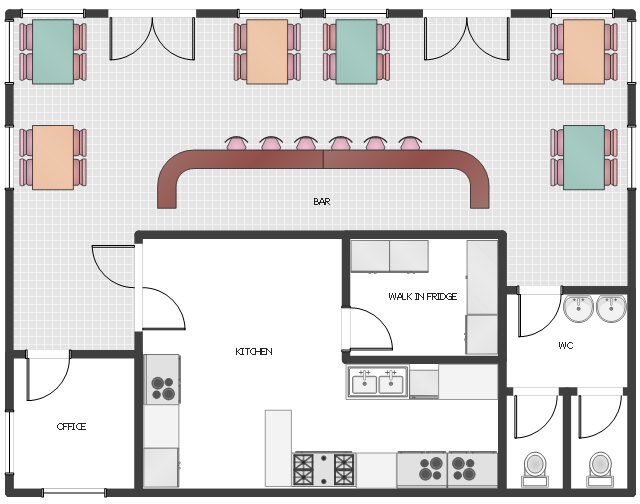
Bakery Kitchen Floor Plan
As in any restaurant, your bakery’s kitchen space is a primary consideration in your floor plans. If you have limited space, think wisely about how you can optimize the space you have for maximum production while leaving enough room for your employees to prep, cook, and bake.
Time, quality, and, eventually, profits are sacrificed when there’s not enough space for employees to do their jobs efficiently. So, make the most of your bakery’s kitchen space by focusing on the production capacity of your menu and your staff. And, remember to leave room for all the necessary equipment to produce your menu.
Consider this bakery kitchen example from SmartDraw as you plan your designs:
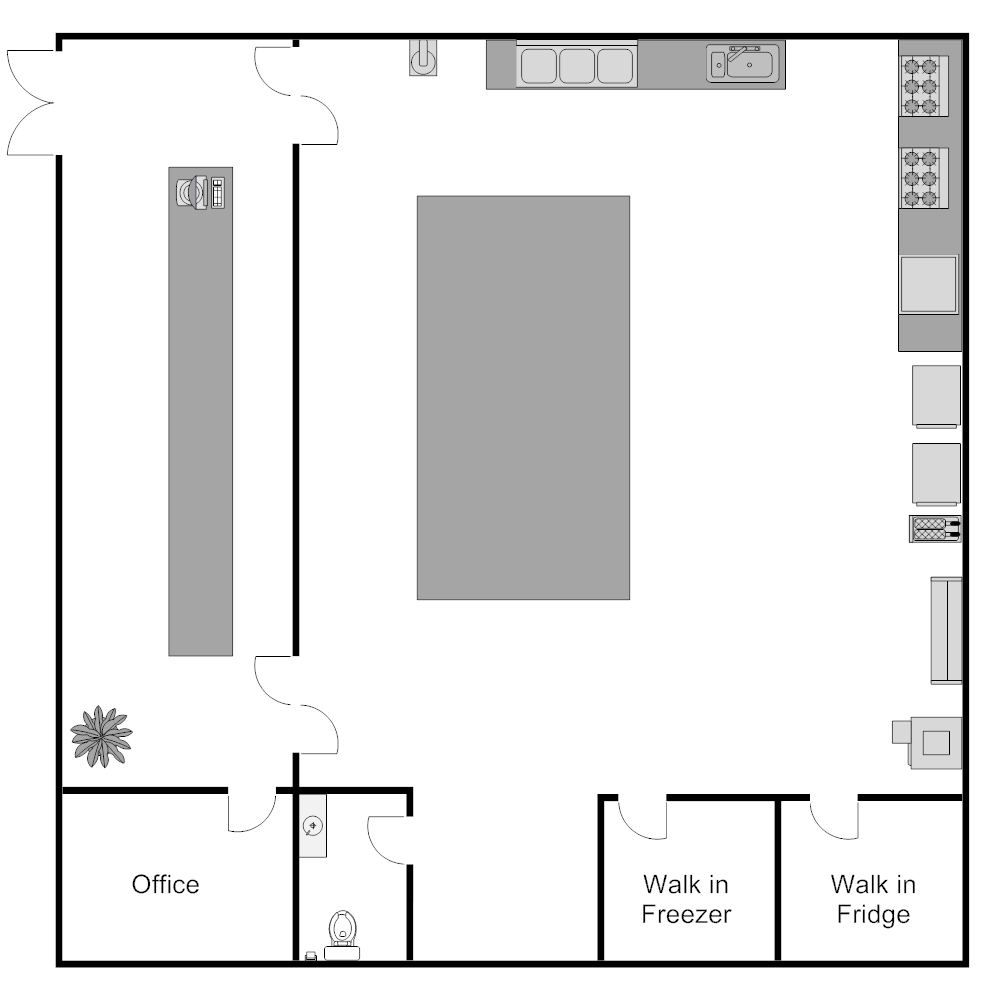
Staff Area Floor Plan
Staff areas (such as offices and break rooms) should always be included in your floor plans. Be sure to set aside back-of-house space for your managers to complete administrative tasks and for all of your staff to take breaks. Designating an area for staff will keep your bakery organized, providing a communal place to post schedules and announcements.
Dining Room Floor Plan
The dining room is arguably the most important blueprint you’ll make – it drives the bulk of the guest experience. Your dining room’s floor plan needs to match the aesthetic of the rest of your bakery.
A sleek, open floor plan is great for a simple, modern bakery. But, if you’re looking to create a cozy community space, you might want to design more intimate spaces.
Consider competing bakeries in the area. What expectations will your community have for your bakery? How will you encourage customers to keep choosing yours? These questions can help you develop a smart floor plan that supports your bakery’s success.
How Much Seating Should a Bakery Have?
To understand your seating plan, consider the industry standard for space. According to Total Food Service, it’s a 60/40 model – 60% of the space is used for guests (and seating) and 40% is used for prep, the coffee bar, and the kitchen.
Another critical step is calculating the maximum occupancy of your space depending on local building codes. These will vary by bakery type and location, but we suggest the following capacity per guest in these types of restaurants (local COVID guidelines may further restrict these calculations:)
- Full-Service Restaurant Dining: 12-15 square feet
- Counter Service: 18-20 square feet
- Fast Food: 11-14 square feet
Let’s give an example using the suggested capacity above. A 3200 square foot bakery space would have 1,920 square feet of space for guests and the capacity for a counter service bakery would be 106 customers. Each guest would have approximately 18 square feet of space.
Offering guests more space is usually a good idea. Spacing tables further apart and creating wide lanes for traffic is a great way to make your bakery accessible to people with disabilities. Plus, a study by Cornell University’s School of Hotel Administration found that guests are more generous with their spending if they have more personal space.
Entrance Floor Plan
It's crucial that your entrance space invites guests in, since it is the first impression they’ll get of your bakery. Design an entrance space that provides guests with necessary information about your bakery, such as where to order, wait, or find restrooms.
Bakeries often operate with counter-service models, so make sure to leave enough space for guests to wait inside for their turn to order. Place the ordering counter near the entrance or guide your customers there with architectural elements.
Of course, your entrance depends on the location and style of service. In an area with lots of foot traffic, like a mall or shopping center, you might not need as much waiting area as in a stand-alone bakery.
Outdoor Seating Floor Plan
If you have the luxury of outdoor space, maximize it. A nice patio can attract a different niche of customers to your bakery and drive additional sales and profits. On the other hand, outdoor space that is out of the way or hard to find can slow service. This could lead to both guests and employees not wanting to use the additional space. To avoid this, design a floor plan that makes the space easy to access for guests and servers.
Restrooms Floor Plan
Believe it or not, restrooms are a deciding factor in many people’s choice of bakeries and restaurants, according to a survey by Zogby International. Designing restrooms that are big enough for all guests and easy to find from the dining areas will give you an edge. Avoid requiring guests to move through staff areas to reach the restroom.
Cashier and POS Station Floor Plan
The POS station is the center of your bakery – it’s where customers communicate with service staff and how service staff communicates with the kitchen. POS technology also keeps track of all your bakery’s operations.
In a counter-service bakery, you’ll likely have one or two POS stations where customers place orders with a cashier. You might also invest in handheld POS devices so that servers can take orders at tables for a full-service bakery.
Cafe and Bakery POS Comparison Tool
A free, customizable Cafe and Bakery POS Comparison Tool to research and compare point of sale systems in one Excel spreadsheet or editable PDF.

Emergency Exits Floor Plan
Bakeries must have a fire and emergency floor plan. Design software can help you adequately map out emergency exit routes. Once your floor plan is completed, be sure to communicate the routes to your staff and clearly mark external exits for customers.
Executing Your Floor Plan
Once you craft detailed blueprints and floor plans, it's time to start turning your plans into a reality. Plumbers, architects, electricians, designers, artists, and your staff can all assist you in building the bakery of your dreams.
Consulting an interior designer can help you to achieve the specific ambiance and experience you want for your customers. They can guide you through painting, decorating, and purchasing furniture that’s functional for your space and suits your aesthetic.
Installing light fixtures in a commercial space should be done by an electrician to be sure it’s up to code – the same goes for plumbing and any structural changes you want to make to your space. Trade professionals can make sure your bakery is up to code and safe for operation.
It’ll also be important to work with city, county, and state officials for all the proper permits for building and blueprints. If possible, maintain good working relationships with the employees in the permit office – they’ll be sure that your blueprints and any changes get approved on time.
This all may seem like a lot of work to do. But, your dream bakery is worth it. So, don’t forget to have fun and be creative! Designing and executing the plans you carefully made for your bakery is exciting – pour all of your passion into the design process and your customers will appreciate it.
Related Bakery Resources
Is this article helpful?
DISCLAIMER: This information is provided for general informational purposes only, and publication does not constitute an endorsement. Toast does not warrant the accuracy or completeness of any information, text, graphics, links, or other items contained within this content. Toast does not guarantee you will achieve any specific results if you follow any advice herein. It may be advisable for you to consult with a professional such as a lawyer, accountant, or business advisor for advice specific to your situation.
Read More
Subscribe to On the Line
Sign up to get industry intel, advice, tools, and honest takes from real people tackling their restaurants’ greatest challenges.
